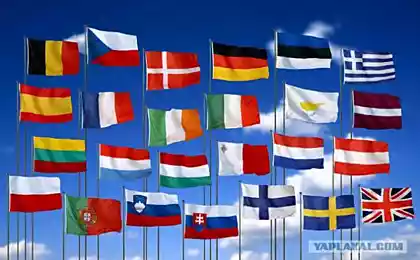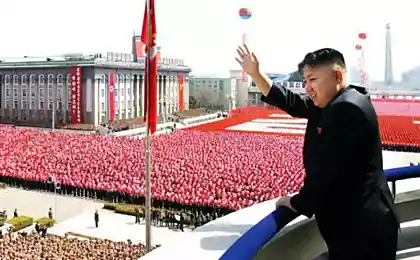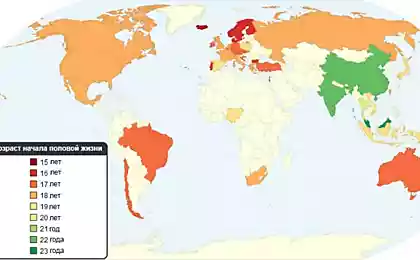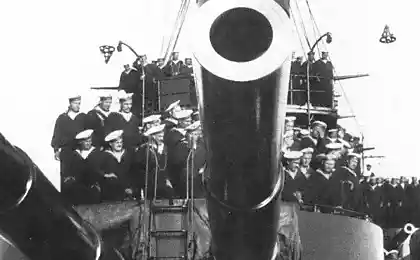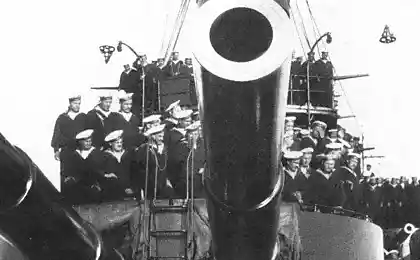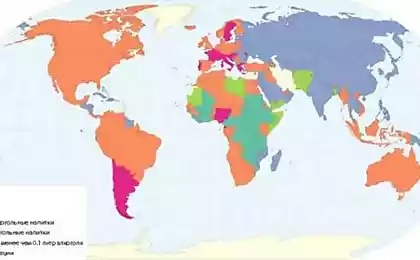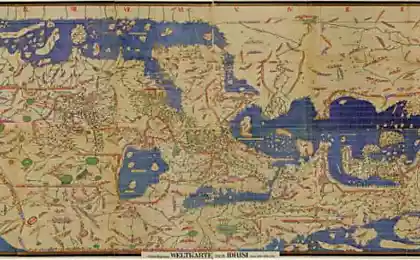2056
Disappeared of the country (10 photos)
New countries appear more frequently than lost, but it happens.
I want to show you the list of countries that have disappeared in the 20th century for one reason or another.
10. The German Democratic Republic (GDR), 1949-1990
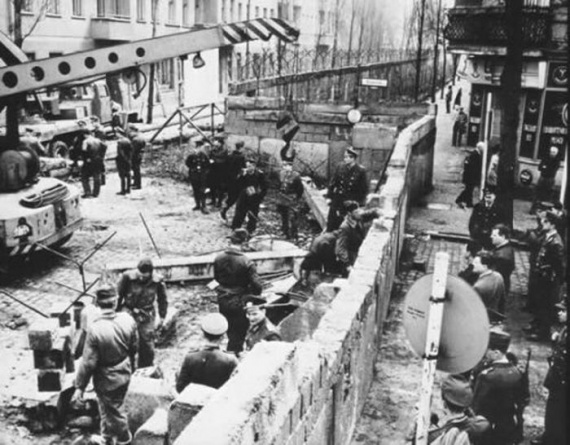
Established after the Second World War in the sector controlled by the Soviet Union, the German Democratic Republic was best known for its walls and a tendency to shoot people trying to cross through it.
Wall was torn down with the collapse of the Soviet Union in 1990. After its demolition of Germany was reunited and again become whole state. However, at the beginning, because of the fact that the German Democratic Republic was a pretty poor integration with the rest of Germany nearly bankrupted the country. Currently in Germany, everything adjusted.
9. Czechoslovakia, 1918-1992
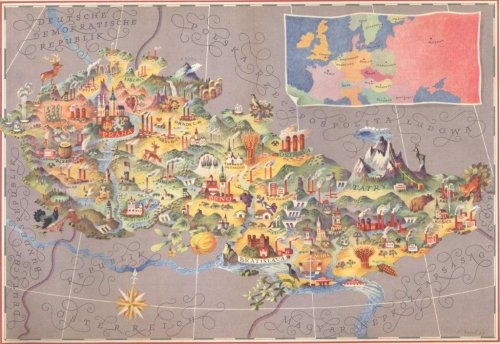
Built on the ruins of the old Austro-Hungarian Empire, during the existence of Czechoslovakia it was one of the most prominent democratic states in Europe before World War II. Betrayed by Britain and France in 1938 in Munich, it was fully occupied by Germany and disappeared from the map of the world in March 1939. Later it was occupied by the Soviets, who made it one of the vassals of the Soviet Union. It was part of the Soviet sphere of influence until its collapse in 1991. After the collapse, she again became a prosperous democratic state.
In this and had to end this story, and perhaps the state would be integral to this day, if the ethnic Slovaks living in the eastern half of the country, do not need to be separated into an independent state, the division of Czechoslovakia into two in 1992.
Today Czechoslovakia is gone, in its place there is the Czech Republic and Slovakia in the west to the east. Although, given the fact that the Czech economy is booming, Slovakia, in which things are not going so well, probably regrets the department.
8. Yugoslavia, 1918-1992
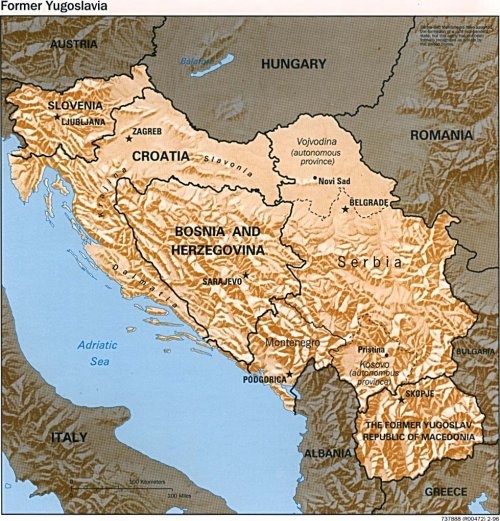
Like Czechoslovakia, Yugoslavia was a product of the collapse of the Austro-Hungarian Empire during the Second World War. Consisting mainly of original parts of Hungary and Serbia, Yugoslavia, unfortunately, did not follow the example of Czechoslovakia more intelligent. Instead, it was something of autocratic monarchy before the Nazis invaded the country in 1941. After that, it was occupied by Germany. After the defeat of the Nazis in 1945, Yugoslavia was not included in the USSR, but has become a communist country under the leadership of the socialist dictator Josip Broz Tito (Marshal Josip Tito), leader of the army of partisans during the Second World War. Yugoslavia remained non-aligned authoritarian socialist republic until 1992, when internal conflicts and irreconcilable nationalism resulted in a civil war. After her country was divided into six small countries (Slovenia, Croatia, Bosnia, Macedonia and Montenegro), becoming a good example of what can happen if the cultural, ethnic and religious assimilation goes wrong.
7. Austro-Hungarian Empire, 1867-1918
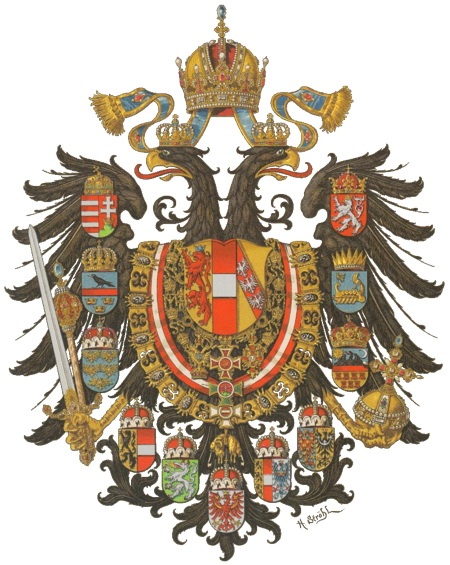
While all the countries that find themselves on the losing side after the First World War, found themselves in an unfavorable economic and geographical position, none of them lost more than the Austro-Hungarian Empire, which had been gnawed like a roast turkey in a homeless shelter. From the collapse of the once vast empire were such advanced countries as Austria, Hungary, Czechoslovakia and Yugoslavia, as part of the lands of the empire departed Italy, Poland and Romania.
So why it broke, while its neighbor, Germany, remained intact? Because she did not have a common language and self-determination, instead it lived the various ethnic and religious groups, who put it mildly, did not get along with each other. In general, the Austro-Hungarian Empire suffered what undergone Yugoslavia, only on a much larger scale, when it tore apart ethnic hatred. The difference was only in the fact that the Austro-Hungarian empire torn apart the winners, and the disintegration of Yugoslavia was an internal and spontaneous.
6. Tibet, 1913-1951
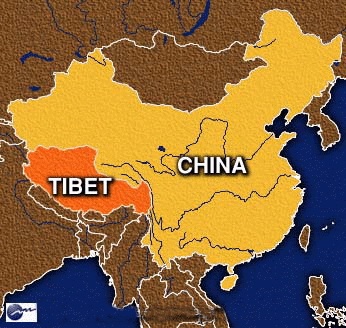
Although the territory, known as Tibet, there was over a thousand years, it could not become an independent state until 1913. However, being under the tutelage of a number of peace the Dalai Lama, he finally faced with Communist China in 1951 and was occupied by the forces of Mao, ending thus its brief existence as a sovereign state. In 50 years, China invaded Tibet, which grew more and more unrest, as long as Tibet in 1959, finally rebelled. This led to the fact that China has annexed the region and dissolved the Tibetan government. Thus, Tibet ceased to exist as a nation, and instead turned into a "region" instead of a country. Today, Tibet is a huge tourist attraction for the Chinese government, despite the fact that between Beijing and Tibet there is strife, due to the fact that Tibet was once again required to return his independence.
5. South Vietnam, 1955-1975
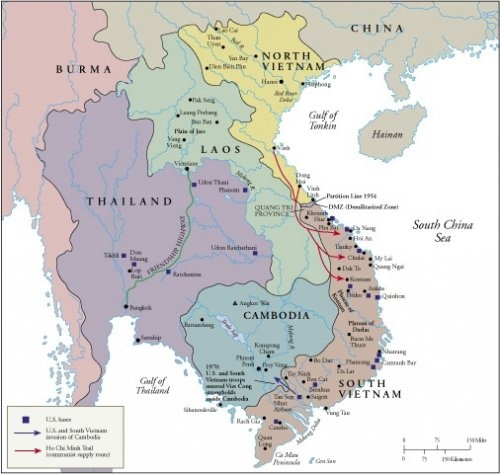
South Vietnam was created by the forcible expulsion of the French from Indochina in 1954. Someone decided that divided Vietnam into two parts of approximately the 17th parallel is a good idea, leaving the Communist Vietnam in the north and pseudo-democratic Vietnam in the south. As in the case of Korea, nothing good came of it. The situation has led to a war between the southern and northern Vietnam, which, in the end, the United States were involved. The war began for the United States of America, one of the most devastating and costly wars in which America has ever been involved. As a result, torn by internal divisions, the US withdrew its troops from Vietnam and gave him to himself in 1973. Within two years, Vietnam, divided into two parts, fought until North Vietnam, supported by the Soviet Union, not seized power over the country, eliminating all of South Vietnam. The former capital of South Vietnam - Saigon (Saigon), was renamed Ho Chi Minh City (Ho Chi Minh City). Since Vietnam is a socialist utopia.
4. The United Arab Republic, 1958-1971

This is another failed attempt to unite the Arab world. The Egyptian president, an ardent socialist, Gamal Abdel Nasser (Gamel Abdel Nasser), found that the association with distant neighbors Egypt, Syria, will lead to the fact that their common enemy - Israel will be surrounded on all sides, and that the united country will become super- force in the region. Thus it was created short-lived United Arab Republic - an experiment that was doomed to failure from the outset. As a divided several hundred kilometers of a centralized government seemed an impossible task, plus everything, Syria and Egypt could never agree on what's consisted national priorities.
The problem would be solved if Syria and Egypt united to destroy Israel. But their plans to prevent inappropriate began the Six Day War of 1967, they plan to destroy their common border and turn the United Arab Republic in the defeat of biblical proportions. After this union days were numbered, and, eventually, the United Arab Republic collapsed with the death of Nasser in 1970. Without the charismatic Egyptian president, who supported the delicate alliance UAR quickly disintegrated, restoring Egypt and Syria as separate states.
3. The Ottoman Empire, 1299-1922
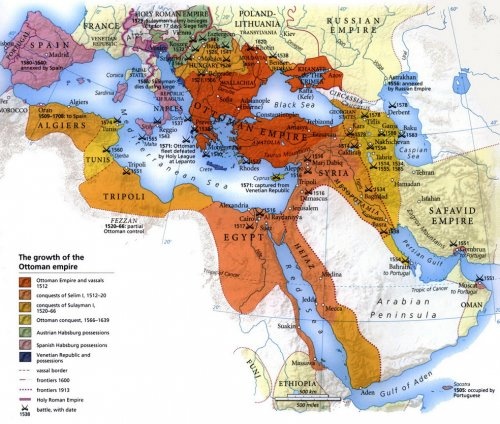
One of the greatest empires in history, the Ottoman Empire collapsed in November 1922, after a fairly long period of its existence for more than 600 years. Once it stretched from Morocco to the Persian Gulf and from Sudan to Hungary. Its decay was the result of a long process of disintegration for many centuries, at the beginning of the 20th century on it was only a shadow of its former glory.
But even then, it remained a powerful force in the Middle East and North Africa, and most likely, it would still be today if it had not participated in World War I on the losing side. After the First World War it was disbanded, the biggest part of it (Egypt, Sudan and Palestine) departed England. In 1922, it became useless and, in the end, completely fell apart when the Turks won their war of independence in 1922, and they feared the sultanate, simultaneously creating a modern Turkey. However, the Ottoman Empire deserves respect for her, as the continued existence in spite of everything.
2. Sikkim (Sikkim), 8 century AD-1975
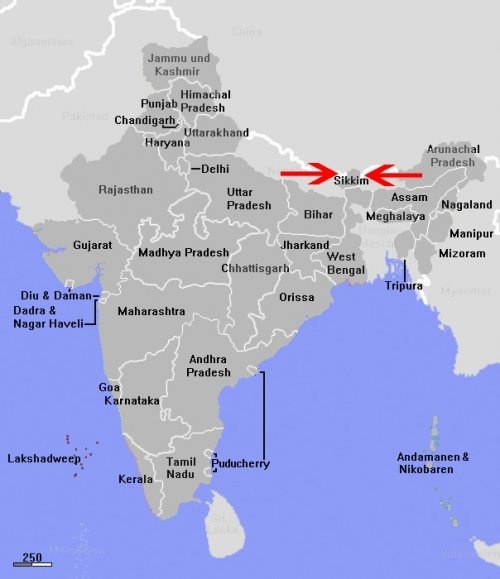
Have you never heard of this country? Where have you been all this time? Well, seriously, as you might not be aware of the small, not landlocked Sikkim is perched safely in the Himalayas between India and Tibet ... I mean, China. The size of a stall selling hot dogs, it was one of those unknown, forgotten monarch who managed to hold out until the 20th century, as long as its citizens do not realize that they have no particular reason to be an independent state, and are not We decided to join forces with modern India in 1975.
What was noticeable is a small country? Yes, the fact that, despite its incredibly small size, it was eleven official languages, which probably create chaos at the signing of road signs - if it is assumed that in Sikkim were expensive.
1. The Union of Soviet Socialist Republics (USSR), 1922-1991

It is difficult to imagine the history of the world without the participation of the Soviet Union. One of the most powerful countries on the planet, which broke up in 1991, seven decades it was a symbol of friendship between the peoples. It was formed after the collapse of the Russian Empire after the First World War and flourished for decades. The Soviet Union defeated the Nazis when the efforts of all the other countries have not been sufficient to stop Hitler. The Soviet Union almost went to war with the United States in 1962, this event has been called "the Cuban missile crisis».
After the Soviet Union collapsed after the fall of the Berlin Wall in 1989, it was divided into fifteen sovereign states, thus creating the biggest bloc of countries with the collapse of the Austro-Hungarian Empire in 1918. Who is the main successor to the Soviet Union is a democratic Russia.
Source: BUGAGA.RU
I want to show you the list of countries that have disappeared in the 20th century for one reason or another.
10. The German Democratic Republic (GDR), 1949-1990

Established after the Second World War in the sector controlled by the Soviet Union, the German Democratic Republic was best known for its walls and a tendency to shoot people trying to cross through it.
Wall was torn down with the collapse of the Soviet Union in 1990. After its demolition of Germany was reunited and again become whole state. However, at the beginning, because of the fact that the German Democratic Republic was a pretty poor integration with the rest of Germany nearly bankrupted the country. Currently in Germany, everything adjusted.
9. Czechoslovakia, 1918-1992

Built on the ruins of the old Austro-Hungarian Empire, during the existence of Czechoslovakia it was one of the most prominent democratic states in Europe before World War II. Betrayed by Britain and France in 1938 in Munich, it was fully occupied by Germany and disappeared from the map of the world in March 1939. Later it was occupied by the Soviets, who made it one of the vassals of the Soviet Union. It was part of the Soviet sphere of influence until its collapse in 1991. After the collapse, she again became a prosperous democratic state.
In this and had to end this story, and perhaps the state would be integral to this day, if the ethnic Slovaks living in the eastern half of the country, do not need to be separated into an independent state, the division of Czechoslovakia into two in 1992.
Today Czechoslovakia is gone, in its place there is the Czech Republic and Slovakia in the west to the east. Although, given the fact that the Czech economy is booming, Slovakia, in which things are not going so well, probably regrets the department.
8. Yugoslavia, 1918-1992

Like Czechoslovakia, Yugoslavia was a product of the collapse of the Austro-Hungarian Empire during the Second World War. Consisting mainly of original parts of Hungary and Serbia, Yugoslavia, unfortunately, did not follow the example of Czechoslovakia more intelligent. Instead, it was something of autocratic monarchy before the Nazis invaded the country in 1941. After that, it was occupied by Germany. After the defeat of the Nazis in 1945, Yugoslavia was not included in the USSR, but has become a communist country under the leadership of the socialist dictator Josip Broz Tito (Marshal Josip Tito), leader of the army of partisans during the Second World War. Yugoslavia remained non-aligned authoritarian socialist republic until 1992, when internal conflicts and irreconcilable nationalism resulted in a civil war. After her country was divided into six small countries (Slovenia, Croatia, Bosnia, Macedonia and Montenegro), becoming a good example of what can happen if the cultural, ethnic and religious assimilation goes wrong.
7. Austro-Hungarian Empire, 1867-1918

While all the countries that find themselves on the losing side after the First World War, found themselves in an unfavorable economic and geographical position, none of them lost more than the Austro-Hungarian Empire, which had been gnawed like a roast turkey in a homeless shelter. From the collapse of the once vast empire were such advanced countries as Austria, Hungary, Czechoslovakia and Yugoslavia, as part of the lands of the empire departed Italy, Poland and Romania.
So why it broke, while its neighbor, Germany, remained intact? Because she did not have a common language and self-determination, instead it lived the various ethnic and religious groups, who put it mildly, did not get along with each other. In general, the Austro-Hungarian Empire suffered what undergone Yugoslavia, only on a much larger scale, when it tore apart ethnic hatred. The difference was only in the fact that the Austro-Hungarian empire torn apart the winners, and the disintegration of Yugoslavia was an internal and spontaneous.
6. Tibet, 1913-1951

Although the territory, known as Tibet, there was over a thousand years, it could not become an independent state until 1913. However, being under the tutelage of a number of peace the Dalai Lama, he finally faced with Communist China in 1951 and was occupied by the forces of Mao, ending thus its brief existence as a sovereign state. In 50 years, China invaded Tibet, which grew more and more unrest, as long as Tibet in 1959, finally rebelled. This led to the fact that China has annexed the region and dissolved the Tibetan government. Thus, Tibet ceased to exist as a nation, and instead turned into a "region" instead of a country. Today, Tibet is a huge tourist attraction for the Chinese government, despite the fact that between Beijing and Tibet there is strife, due to the fact that Tibet was once again required to return his independence.
5. South Vietnam, 1955-1975

South Vietnam was created by the forcible expulsion of the French from Indochina in 1954. Someone decided that divided Vietnam into two parts of approximately the 17th parallel is a good idea, leaving the Communist Vietnam in the north and pseudo-democratic Vietnam in the south. As in the case of Korea, nothing good came of it. The situation has led to a war between the southern and northern Vietnam, which, in the end, the United States were involved. The war began for the United States of America, one of the most devastating and costly wars in which America has ever been involved. As a result, torn by internal divisions, the US withdrew its troops from Vietnam and gave him to himself in 1973. Within two years, Vietnam, divided into two parts, fought until North Vietnam, supported by the Soviet Union, not seized power over the country, eliminating all of South Vietnam. The former capital of South Vietnam - Saigon (Saigon), was renamed Ho Chi Minh City (Ho Chi Minh City). Since Vietnam is a socialist utopia.
4. The United Arab Republic, 1958-1971

This is another failed attempt to unite the Arab world. The Egyptian president, an ardent socialist, Gamal Abdel Nasser (Gamel Abdel Nasser), found that the association with distant neighbors Egypt, Syria, will lead to the fact that their common enemy - Israel will be surrounded on all sides, and that the united country will become super- force in the region. Thus it was created short-lived United Arab Republic - an experiment that was doomed to failure from the outset. As a divided several hundred kilometers of a centralized government seemed an impossible task, plus everything, Syria and Egypt could never agree on what's consisted national priorities.
The problem would be solved if Syria and Egypt united to destroy Israel. But their plans to prevent inappropriate began the Six Day War of 1967, they plan to destroy their common border and turn the United Arab Republic in the defeat of biblical proportions. After this union days were numbered, and, eventually, the United Arab Republic collapsed with the death of Nasser in 1970. Without the charismatic Egyptian president, who supported the delicate alliance UAR quickly disintegrated, restoring Egypt and Syria as separate states.
3. The Ottoman Empire, 1299-1922

One of the greatest empires in history, the Ottoman Empire collapsed in November 1922, after a fairly long period of its existence for more than 600 years. Once it stretched from Morocco to the Persian Gulf and from Sudan to Hungary. Its decay was the result of a long process of disintegration for many centuries, at the beginning of the 20th century on it was only a shadow of its former glory.
But even then, it remained a powerful force in the Middle East and North Africa, and most likely, it would still be today if it had not participated in World War I on the losing side. After the First World War it was disbanded, the biggest part of it (Egypt, Sudan and Palestine) departed England. In 1922, it became useless and, in the end, completely fell apart when the Turks won their war of independence in 1922, and they feared the sultanate, simultaneously creating a modern Turkey. However, the Ottoman Empire deserves respect for her, as the continued existence in spite of everything.
2. Sikkim (Sikkim), 8 century AD-1975

Have you never heard of this country? Where have you been all this time? Well, seriously, as you might not be aware of the small, not landlocked Sikkim is perched safely in the Himalayas between India and Tibet ... I mean, China. The size of a stall selling hot dogs, it was one of those unknown, forgotten monarch who managed to hold out until the 20th century, as long as its citizens do not realize that they have no particular reason to be an independent state, and are not We decided to join forces with modern India in 1975.
What was noticeable is a small country? Yes, the fact that, despite its incredibly small size, it was eleven official languages, which probably create chaos at the signing of road signs - if it is assumed that in Sikkim were expensive.
1. The Union of Soviet Socialist Republics (USSR), 1922-1991

It is difficult to imagine the history of the world without the participation of the Soviet Union. One of the most powerful countries on the planet, which broke up in 1991, seven decades it was a symbol of friendship between the peoples. It was formed after the collapse of the Russian Empire after the First World War and flourished for decades. The Soviet Union defeated the Nazis when the efforts of all the other countries have not been sufficient to stop Hitler. The Soviet Union almost went to war with the United States in 1962, this event has been called "the Cuban missile crisis».
After the Soviet Union collapsed after the fall of the Berlin Wall in 1989, it was divided into fifteen sovereign states, thus creating the biggest bloc of countries with the collapse of the Austro-Hungarian Empire in 1918. Who is the main successor to the Soviet Union is a democratic Russia.
Source: BUGAGA.RU



